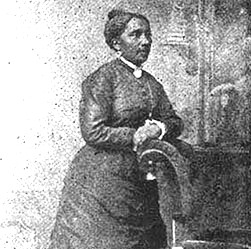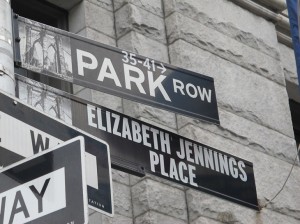
Elizabeth Jennings was a sister with an attitude. About 100 years before Rosa Parks, Elizabeth Jennings refused to get off a horse-drawn streetcar in New York when ordered to. Think of Miss Jennings as a ‘Rosa Parks’ with a New York attitude. Not only did the 24 year-old teacher and church organist refuse to get off the horse-drawn streetcar, but she fought the driver, conductor and policeman, reminded them of her rights, sued them and the transit company and won! Oh, and did I mention that her lawyer went on to become president of the United States? More on that later. Thanks to some conscientious New York City school children, a street was named Elizabeth Jennings Place in Lower Manhattan in 2007 at Park Row and Spruce Street. More on the school children later.
I first heard about Miss Jennings (later she married Charles Graham) from Rev. Dr. Calvin Butts who preached about her from the pulpit at Harlem’s Abyssinian Baptist Church years ago in honor of Black History Month. Elizabeth Jennings is one of my favorite unsung sheroes. She was courageous and outrageous, two important qualities needed in the long struggle for women’s equal rights in this nation.
Miss Jennings was wealthy and educated during a time when most African Americans were not. In fact, most were enslaved. Can you imagine being a BAP-Black American Princess during slavery? Her father was a successful, well-connected tailor with a shop on Church Street. He held patents on methods for renovating clothing and was an abolition leader at two major Black churches— Abyssinian and St. Phillips, both located in Lower Manhattan, New York’s original Black community! Usually, Miss Jennings was transported around town by her chauffeur. But on this day she and her friend Sarah E. Adams were running late for choir practice at the First Colored Congregational Church on Sixth Street and Second Avenue. She flagged the streetcar that picked her and her companion up at Pearl and Chatham streets on Sunday, July 16, 1854. Then, things went downhill. The conductor and driver tried to kick her off.

The Details— Here’s an account that was read aloud (as she was still recovering from injuries, her words were read by the meeting secretary) from an open letter to the church rally and as published in Horace Greeley’s New York Tribune, July 19, 1854, 7:2 (edited) article: Outrage Upon Colored Persons – “I held my gloved hand up to the driver and he stopped the cars. We got on the platform, when the conductor told us to wait for the next car. I told him I could not wait, as I was in a hurry to go to church. He insisted upon my getting off, but I did not get off. He waited a few minutes, when the driver, becoming impatient, said to me, “Well, you may go in, but remember, if the passengers raise any objections you shall go out, whether or no, or I’ll put you out.”
I then told him that I was a respectable person, born and raised in New York, that I had never been insulted before while going to church, and that I did not know where he came from but that he was a no good for nothing impudent fellow for insulting decent persons while on their way to church. He then said that he would put me out.
I told him not to lay his hands on me. He took hold of me and I took hold of the window sash and held on; he pulled me until he broke my grasp and I took hold of his coat and held onto that but previously he had dragged my companion out, she was all the while screaming for him to let go of me. A crowd gathered. The driver then went to his horses. I went again into the car. The conductor said, “You shall sweat for this.”
He then told the driver to drive as fast as he could and not to take another passenger in the car, to drive until he saw an officer or a Station House. We saw an officer at the corner of Walker and Bowery and he without listening to anything that I had to say, thrust me out, and then pushed me down, and tauntingly told me to get redress if I could. I would have come up myself, but am quite sore and stiff from the treatment that I received from those monsters in human form yesterday afternoon.” (this account was picked up by Black and White newspapers across the nation!)
New York, being the financial capital of slavery during the time, was full of organized movements among successful, free, Black New Yorkers to end discrimination and slavery. These activities were led by her father, Thomas Jennings and his notable white and black friends and colleagues. Frederick Douglass, her father’s dear friend, publicized Miss Jennings’ story and it became a national sensation. A huge community rally was held and a Black Legal Rights Association, a precursor to the NAACP, was formed at the First Colored Congregational Church. She decided to sue.
Jennings Wins in Court—Jennings did win her landmark case Jennings V. Third Avenue Rail. Frederick Douglass’ paper, March 2, 1855, 2:5 “Legal Rights Vindicated,” stated: “Our readers will rejoice with us in the righteous verdict. Miss Elizabeth Jennings, whose courageous conduct in the premises is beyond all praise, comes of a good old New York stock. Her grandfather, Jacob Cartwright, a native African, was a soldier in the Revolutionary War, and took part in city politics until his death in 1824; her father Mr. Thomas L. Jennings, mentioned in our paper many times, is founder and leader of institutions for the benefit and elevation of the colored people…”
The case was also reported in a New York Tribune, February 23, 1855, 7:4. article “A Wholesome Verdict.” Judge Rockwell of Brooklyn Circuit Court instructed the jury that the transit company was “liable for the acts of their agents, whether committed carelessly and negligently, or willfully and maliciously. That they were common carriers, and as such bound to carry all respectable persons including colored persons.”
Furthermore, the judge said: “Colored persons if sober, well behaved and free from disease, had the same rights as others and could neither be excluded by any rules of the Company, nor by force or violence.”
Miss Jennings sued for $500 and the majority of the jury wanted to give her the full amount. But as the Tribune stated: “Some jury members had peculiar notions as to colored people’s rights.” (BTW, the transit driver, conductor and police were all Irish immigrants, it was stated in the court proceedings.)
Miss Jennings’ lawyer—A settlement of $225, with the court adding 10 percent, plus her legal expenses was the final agreement. Within a month of this case, an African American man sued and won a similar public transit case and settled out of court. Miss Jennings’ lawyer Chester A. Arthur, later became a Civil War officer and politician. He was elected US Vice President in 1880 and became US President when President James Garfield was murdered in 1881.
Civil War Draft Riots—Some years later after the Jennings’ case, in July 1863, a resolution allowed wealthy New Yorkers to buy their way out of the Civil War draft. An angry white mob, mostly Irish immigrants who competed for slave work and blamed the Black people for the Civil War, rioted over a four-day period. More than 70 African Americans, mostly, successful, free men, women and children were killed and over 20 were lynched. Elizabeth Jennings Graham’s young son died during that time.
NYC Pupils Saved Elizabeth Jennings from Obscurity—In the end I say, God bless the New York City public school children, their teachers and parents who saved Miss Elizabeth Jennings from obscurity.
‘”After finding out about Elizabeth Jennings in preparation for a show on Martin Luther King Jr., a group of third and fourth graders from P.S. 361 on the Lower East Side took the initiative in 2007 to get her name immortalized at the corner of Spruce Street and Park Row. After a year of attending meetings, gathering petition signatures, and pressuring elected officials, they were able to get a street sign named for her—a feat that had been unsuccessful by another group of students in 1990s,” stated a blog posted on womensenews.org called “The Story Behind Elizabeth Jennings Place.”
“In 1991, four sixth grade girls in the Museum of the City of New York’s Wednesday afternoon history club researched the life of Elizabeth Jennings, whom they called the Rosa Parks of her time, and presented a play, ”Elizabeth Jennings Fights for Her Rights,” at the museum’s first history fair. At the fair they collected signatures on a petition asking for the City Council to name one of the corners of Park Row (originally Chatham Street) and Pearl Street in honor of Elizabeth Jennings and forwarded the petitions to the City Council. Unfortunately, the Council never responded, according to a “Letter to the Editor” by Kathleen Benson, head of Education, Museum of the City of New york, September 17, 1994,” it was reported in NY Times article “A Civil Rights Victory in Old New York.”
